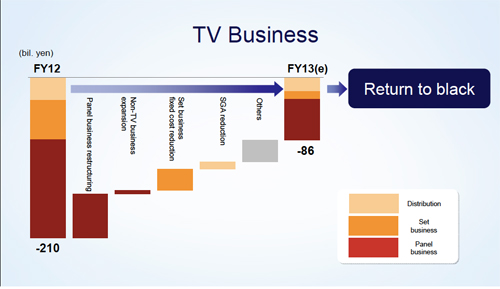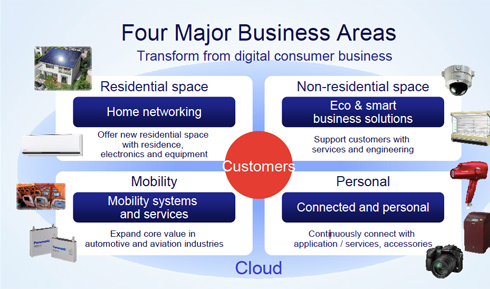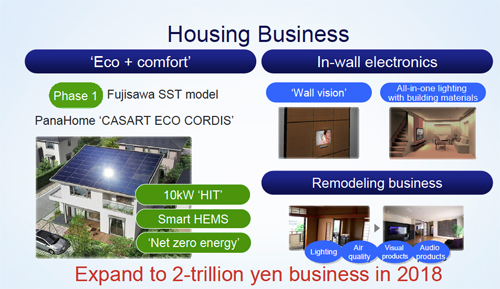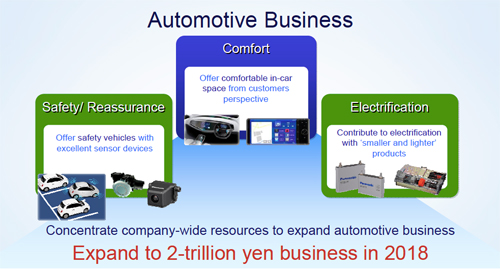How Panasonic's three-year plan will continue the struggle to make money from TVs

'The first thing we have to do under this business plan is get rid of the loss-making businesses'.
That's the stark message from Panasonic president Kazuhiro Tsuga.
He was speaking earlier this evening in Japan, at a press conference to unveil his company's New Midterm Management Plan, which outlines where Panasonic wants to be by 2016.
In simple terms, where it wants to be is not making the ¥772bn (£5.4bn) loss it made last year, nor the ¥765bn it has been forecasting for the current financial year.
And as loss-making Panasonic businesses go, they don't get much lossier than TVs: its TV division lost ¥210bn (almost £1.5bn) in the 2012 financial year and – although things are getting better – its's still going to cost the company an estimated ¥86bn (£602m) of red ink this year.


However, although Tsuga (right) has previously said he wants to move the company beyond being one focused on consumer's living-rooms, he's decided against what some saw as his 'nuclear option' – a complete pull-out from the TV business – and has instead committed himself to turning the division around.
Similarly, the company's mobile phone division stays, transferred to its business-to-business operations with plans for a range of ruggedised phones for business and industrial users.
Get the What Hi-Fi? Newsletter
The latest hi-fi, home cinema and tech news, reviews, buying advice and deals, direct to your inbox.
Back to black
Tsuga says pulling out of mobile phones or TVs is seen as the 'last resort'. As he says of the company's TV operations in his presentation given today, 'I am determined to turn this business to black during this midterm management plan.'
So, hats thrown in the air, general rejoicing all round as the future of Panasonic's TVs is assured, then?
Not quite: though the company seems committed to the TV market for at least the term of this plan, there are some significant points to be taken from today's presentation.
First, there's the main statement of intent for the TV business, which appears as item 1 on the list of restructuring priorities: while it seems it will survive as a whole, part of the plan involves 'eliminating unprofitable business divisions', and for the TV business that means it should 'Focus on major market, expand non-TV business'.
And with Tsuga already committed to restructure the company's TV panel business, and reduce fixed costs in the manufacturing of TV sets, plus the intention in the plan as a whole to 'Expand business and improve efficiency [by] shifting from [an] in-house approach', it looks like more of the company's components and production will be sourced from outside the Panasonic family.
The urban space plan
Indeed, Panasonic's aim, as Tsuga said in his keynote at CES 2013 at the beginning of the year, is that 'We are shifting our focus from [the[ digital consumer business to [a] "space solution" business, and [a] business which connects customers.'
Don't quite get that? Maybe these three slides from Tsuga's presentation will give you a clearer idea of where the company is going.

Panasonic: moving into space...

...The further rise of the Panahome...

...And a three-year, £14bn roadtrip
But what of the much-discussed suggestion that the company is having a major rethink about its TV technologies? Well, the Panasonic statement we published yesterday suggests there are no firm plans in this area at the moment, and makes it clear that the company will continue sell its entire TV range, but one comment in Tsuga's three-year plan piqued my interest.
The solution is... solutions
He says 'We will shift our strategy from vertical integration based on B2C' - that's making products to sell to consumers – 'such as [the] PDP business' – that's plasma display panels – 'to "broad solutions expanding throughout all the space from the customers' perspective with our strong technology."'
And in another move strengthening this strategy, former president Fumio Ohtsubo is stepping down earlier than expected from his current role as chairman, to be replaced by Shusaku Nagae, current president of Panasonic's Eco Solutions and its solutions business.
See, it's that idea of making solutions rather than things again: Panasonic is moving away from making products to sell to you and me, and wants to change into a manufacturer able to partner with other companies and industries to offer complete solutions, whether in new or renovated homes, on the move, or at the office.
In other words, whatever happens, the Panasonic emerging from the end of this three-year plan is likely to be a very different company to the one we know now.
Written by Andrew Everard
Andrew has written about audio and video products for the past 20+ years, and been a consumer journalist for more than 30 years, starting his career on camera magazines. Andrew has contributed to titles including What Hi-Fi?, Gramophone, Jazzwise and Hi-Fi Critic, Hi-Fi News & Record Review and Hi-Fi Choice. I’ve also written for a number of non-specialist and overseas magazines.
